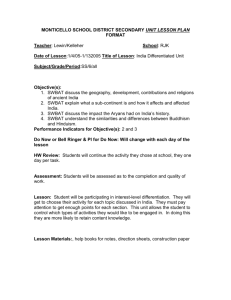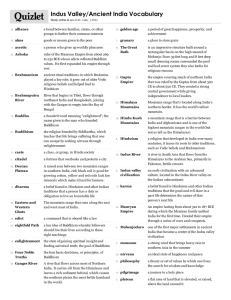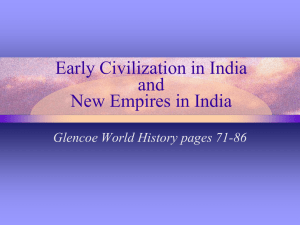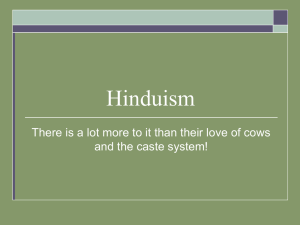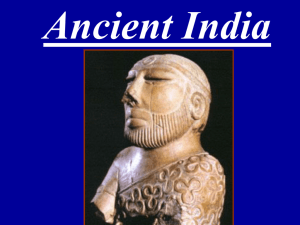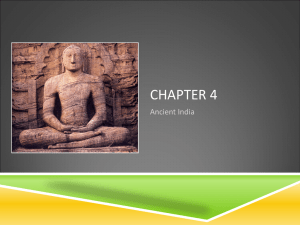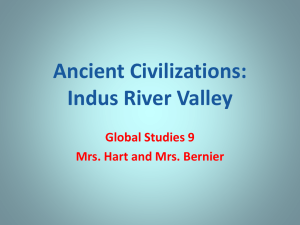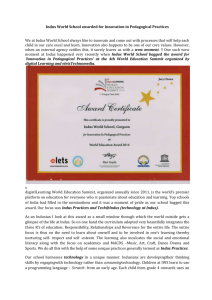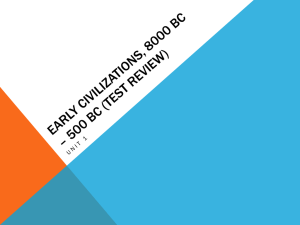Ancient India
advertisement
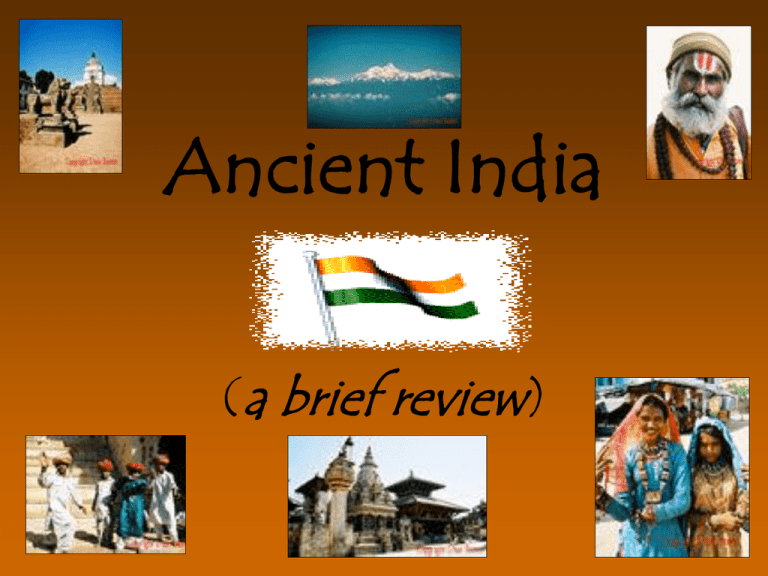
Ancient India (a brief review) Environment Way of Life Indus Valley Agriculture Silt Specialization Ancient India Harappans Aryans People Vedas Mohenjo-Daro Achievements Environment Himalayas 1. The Indus River brings water and silt that make farming possible. 2. It begins in the Himalayas and crosses desert plains before reaching the Arabian Sea. 3. Ancient Indus River Valley farmers irrigated their fields and built dirt walls to protect their crops and homes from floods. Indus River Valley Himalayas Indus River Indus Plain Ganges River Arabian Sea Bay of Bengal Map of India 1. What is the source of the Indus River? 2. How does it become a more powerful river as it reaches the Indus Plain? 3. Why does the Indus flood the plain? India ahead! This subcontinent is surrounded by the Arabian Sea, Indian Ocean and the Bay of Bengal. The Indus River and the Ganges River are also large bodies of water that run through India. People / Way of Life 1.There is little known about the Harappan civilization because its writing system still has not been translated. 2. Mohenjo-Daro consisted of many brick buildings and a huge citadel. The city also had a sewer system. 3. Because of the orderly layout of the city and its long grain warehouse suggest that Mohenjo-Daro was ruled by a strong local government. 4. Harapan merchants traded goods in many places, some of which were as far away as Mesopotamia. 5. A people called “Ayrans” migrated to the Indian subcontinent in about 1500 B.C. They brought new ideas to the region. Mohenjo-Daro Harappa • Why is there little known about the Harappan civilization? 2. What kinds of technologies made Mohenjo-Daro a highly livable city? 3. Why is it believed that Mohenjo-Daro had a strong government? 4. Who migrated to the Indus Valley about 1500 B.C.? Religion Shiva A. Hinduism 1.Hinduism is one of the oldest religions in the world and is practiced by over 800 million people. 2. The Aryan newcomers introduced sacred songs written in the Vedas. They became the foundation of Hinduism. 3. The Vedas supported a way of dividing Hindu society into four major classes of people. These four classes developed into the caste system. Hinduism (contd.) 4. Reincarnation, the idea that people live in a constant circle of birth, death, and rebirth is an important theme in the religion. 5. Hindus believe by listening to the dharma, or instruction (laws and duties) of their caste, they can break free of the cycle of reincarnation. Ganesha Hanumana 1. What is the foundation of Hinduism? 2. What is the caste system? 3. What is reincarnation? 4. How can a person break free of reincarnation? B. Buddhism 1. Between the years 1500 – 500B.C., the Aryan rulers gained control of much of India and spread Hinduism. 2. The founder of Buddhism, Siddhartha Gautama gave up all he owned to search for peace and a way to end suffering. 3. The Buddha borrowed beliefs from Hinduism. He also taught the Four Noble Truths, the Eightfold Path, and the Middle Way. Copper model of Buddha Buddhism (contd.) 4. Buddhism spread after his death. Today there are an estimated 330 million followers of this religion. Siddhartha Guatama 1. How did the Aryan power grow from 1500 B.C. 2. What major life decision did Siddhartha Gautama make as a young man in his palace? 3. How would you describe the major beliefs of Buddhism? Buddhist Monk The End

